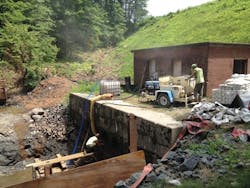40 Feet Deep & About to Fail
Tomhannock Reservoir in New York state is more than 5 miles long and holds 12.3 billion gal when full. Parts of the reservoir’s earth-filled dam date back to 1900, and as the only water source for the city of Troy, draining the reservoir for repairs is nearly impossible.
In early 2013, the dam’s bottom outlet was failing. The 310-ft-by-60-in. riveted steel pipe was leaking and threatening to collapse. On the reservoir side, the inlet is about 40 ft below the reservoir surface and closed by a gate that opens to release water. On the downstream side, to prevent erosion, the pipe opens into a diffusion chamber that diverts water to four short 30-in. pipes. Without access from the reservoir side, all work would have to be done from the diffuser chamber, a small space about 4.5 ft wide, 5 ft high and 12 ft long.
Staging constraints led Ryan Arold, vice president of trenchless for Arold Construction Co. Inc., to recommend CentriPipe—a centrifugally cast concrete pipe (CCCP) technology that repairs failing pipe by inserting a spincaster into a pipe to spray thin layers of high-strength cementitious grout onto the pipe interior. Arold set up the spincaster’s withdrawal winch in the diffusion chamber and ran in power, air and concrete hoses from outside the dam through the 30-in. diffusion pipes. Substantial scaffolding was built, giving safe access to the outlets 10 in. above the ground. Dewatering was accomplished by slowing leaks with hydraulic cement repairs, and installing a sandbag and poly sheet cofferdam to hold back water for about five hours.
The CCCP design called for a 1-in. application of PL-8000, a high-strength grout manufactured by AP/M Permaform, but a little more than 1.5 in. was applied in a total of five passes to cover the thick bolt heads completely and ensure a long-lasting, water-tight, structurally sound rehabilitated pipe.
Download: Here


